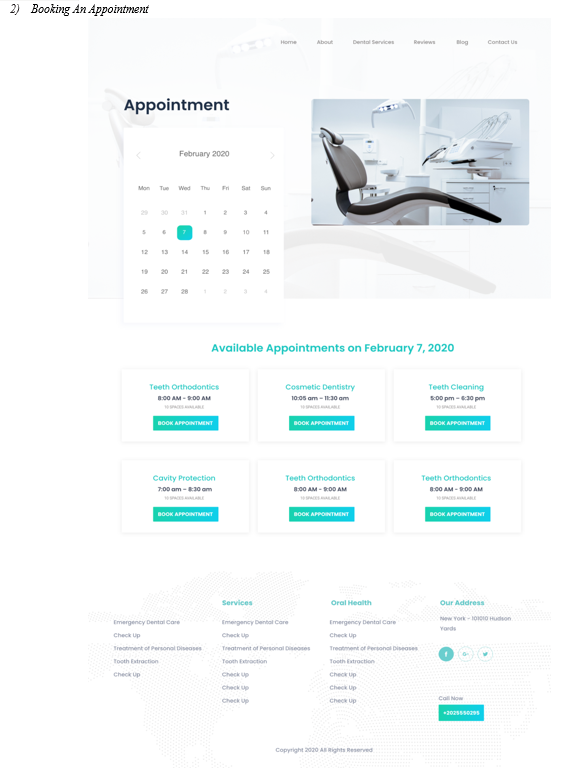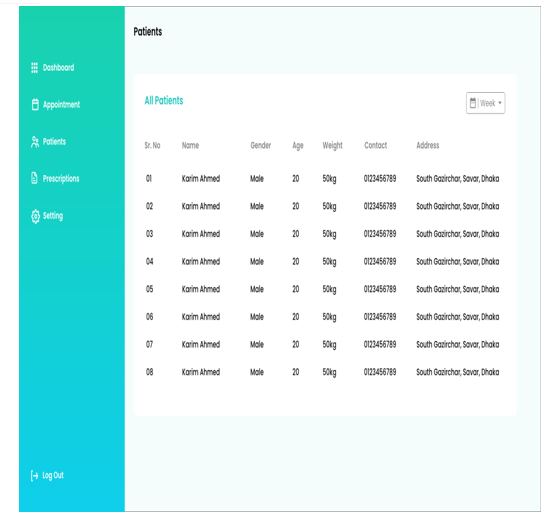Ijraset Journal For Research in Applied Science and Engineering Technology
- Home / Ijraset
- On This Page
- Abstract
- Introduction
- Copyright
Doctor App- Manipal Health Enterprise
Authors: Mahboob Sharief , Shaik Asif Basha, Zaheer Hussain V, Dr. G. Vennira Selvi
DOI Link: https://doi.org/10.22214/ijraset.2024.58006
Certificate: View Certificate
Abstract
The \"Doctor App - Manipal Health Enterprise\" is a comprehensive healthcare solution designed to enhance the efficiency, accessibility, and quality of healthcare services provided by Manipal Health, a leading healthcare enterprise. This innovative mobile application aims to bridge the gap between healthcare providers and patients, offering a seamless and user-friendly platform for medical consultations, appointments, and health management. The app facilitates remote medical consultations, allowing patients to connect with experienced healthcare professionals from Manipal Health Enterprise. This feature promotes timely access to medical advice and reduces the need for in-person visits. Users can conveniently schedule appointments with healthcare practitioners through the app. This feature streamlines the booking process, reducing waiting times and optimizing the overall patient experience. The app integrates a secure EHR system, enabling patients and healthcare providers to access and manage medical records digitally. This enhances coordination between different healthcare services and ensures comprehensive patient care. The application prioritizes data security and ensures encrypted communication between patients and healthcare professionals. This commitment to privacy instills confidence in users to share sensitive health information. The \"Doctor App - Manipal Health Enterprise\" not only simplifies healthcare access but also fosters a patient-centric approach by leveraging technology to enhance communication and collaboration between healthcare providers and patients. By embracing the digital transformation of healthcare services, Manipal Health Enterprise aims to deliver a more efficient, patient-friendly, and comprehensive healthcare experience.
Introduction
I. INTRODUCTION
In the rapidly evolving landscape of healthcare, the integration of technology has become pivotal in enhancing the accessibility, efficiency, and overall quality of medical services. In response to this paradigm shift, Manipal Health Enterprise introduces the "Doctor App" – a revolutionary mobile application designed to redefine the patient-doctor relationship and elevate the healthcare experience for all stakeholders.
Manipal Health Enterprise, a distinguished name in the healthcare sector, recognizes the need for innovative solutions that address the evolving demands of patients while optimizing the operational efficiency of healthcare providers. The "Doctor App" is conceived as a comprehensive platform that not only simplifies the process of medical consultations but also empowers individuals to take a proactive role in managing their health.
Effective appointment scheduling and care coordination are essential for delivering high-quality healthcare. Mobile technology presents opportunities to address the challenges faced by doctors in managing appointments and coordinating care teams. This presentation aims to explore the key research findings on appointment scheduling systems, care coordination apps, and mobile health apps for doctors.
By summarizing the literature, we can gain insights to inform the development of a comprehensive doctor appointment planning application. • The goal is to streamline appointment scheduling, enhance care coordination, and ensure continuity of patient care through the use of mobile technology .
In essence, the "Doctor App – Manipal Health Enterprise" represents a significant step towards a patient-centric and technologically advanced healthcare ecosystem. By leveraging the power of digital innovation, Manipal Health aims to redefine the healthcare experience, making it more accessible, efficient, and tailored to the evolving needs of patients in the modern era.
II. LITERATURE SURVEY
Appointment scheduling systems integrated with electronic medical records (EMR) have shown promising results in reducing patient wait times and physician overtime. Care coordination apps have demonstrated the potential to improve communication and efficiency among care teams, but few have been specifically tailored for physicians coordinating outpatient care. Mobile apps designed for doctors have shown positive outcomes in terms of improved organization, coordination, and clinical decision making. The literature suggests that mobile tools with job-specific features can add value to physicians' workflow and enhance patient care.
By leveraging technology, a comprehensive doctor appointment planning application can optimize appointment scheduling, care coordination, and continuity of patient care.
- Mobile Health Applications in Healthcare: The integration of mobile applications in healthcare has gained substantial attention in recent literature. Studies (e.g., Mosa et al., 2012; Free et al., 2013) highlight the potential of mobile health (mHealth) apps in improving patient engagement, health monitoring, and facilitating remote consultations. The "Doctor App" aligns with this trend, offering a platform that extends healthcare services beyond traditional boundaries.
- Patient-Doctor Communication through Digital Platforms: Literature emphasizes the significance of effective communication between patients and healthcare providers. Research (e.g., Ha et al., 2017; Greenhalgh et al., 2016) underscores the positive impact of digital platforms on enhancing communication channels. The "Doctor App" acknowledges the importance of secure and efficient communication, providing a platform for virtual consultations and secure information exchange.
- Electronic Health Records (EHR) in Healthcare: The adoption of Electronic Health Records is a transformative aspect of modern healthcare. Studies (e.g., Adler-Milstein et al., 2017; Buntin et al., 2010) discuss the benefits of EHR systems in improving data accessibility, care coordination, and patient outcomes. The inclusion of a secure EHR system in the "Doctor App" aligns with these findings, contributing to a more integrated and patient-centric healthcare approach.
- Telemedicine and Virtual Consultations: The concept of telemedicine and virtual consultations has been explored extensively in the literature (e.g., Bashshur et al., 2016; Dorsey et al., 2015). The literature suggests that virtual consultations offer convenience, reduce healthcare costs, and improve access to specialized care. The "Doctor App" capitalizes on these advantages, providing users with a virtual platform for consultations with Manipal Health's healthcare professionals.
- Patient Empowerment and Health Literacy: Empowering patients to actively participate in their healthcare is a recurring theme in the literature (e.g., Nutbeam, 2000; Sørensen et al., 2012). The "Doctor App" contributes to patient empowerment by offering tools for health monitoring, access to personal health records, and educational resources, aligning with the broader goal of promoting health literacy and patient engagement.
III. RESEARCH GAPS OF EXISTING METHODS
Identifying research gaps is crucial for shaping future studies and refining the development of the "Doctor App – Manipal Health Enterprise." Here are potential research gaps that could be addressed in future investigations:
- User Experience and Acceptance: Research could delve into understanding the user experience and acceptance of the "Doctor App." Exploring factors such as user satisfaction, ease of use, and barriers to adoption would provide valuable insights. Additionally, investigating the preferences and concerns of both patients and healthcare professionals can guide improvements in app design and functionality.
- Effectiveness of Virtual Consultations: While the benefits of virtual consultations are widely acknowledged, further research could focus on the effectiveness of these consultations in comparison to traditional in-person visits. Assessing patient outcomes, adherence to treatment plans, and overall satisfaction with virtual interactions would contribute to a comprehensive understanding of the app's impact on healthcare delivery.
- Security and Privacy Concerns: As the app deals with sensitive health information, research should address security and privacy concerns. Investigating the robustness of the app's security measures, user perceptions of data privacy, and compliance with healthcare regulations would ensure the app meets the highest standards of data protection.
- Health Outcomes and Preventive Care: A research gap exists in assessing the long-term health outcomes associated with using the app. Exploring how the app contributes to preventive care, disease management, and overall health and wellness would provide valuable insights into its impact on population health.
- Integration with Existing Healthcare Systems: The "Doctor App" is likely to be part of a larger healthcare ecosystem. Research could explore the challenges and opportunities associated with integrating the app with existing healthcare systems, Electronic Health Records (EHR) platforms, and other digital health tools. This would enhance interoperability and streamline healthcare delivery.
Disadvantages:
a. Digital Literacy Barriers: The "Doctor App" may face challenges related to digital literacy, especially among older or technologically inexperienced populations. Users who are not familiar with smartphone applications or digital health tools may find it difficult to navigate the app effectively.
b. Privacy Concerns and Data Security: Despite efforts to ensure security, users may have concerns about the privacy and security of their health data.
Addressing potential breaches, ensuring robust encryption, and transparently communicating security measures are essential to build and maintain user trust.
c. Depersonalization of Healthcare: The app's emphasis on virtual consultations may lead to concerns about depersonalization of healthcare. Patients and healthcare providers may worry about losing the personal touch and comprehensive understanding that in-person interactions can provide.
d. Limited Physical Examination: Virtual consultations have limitations in terms of physical examinations. Certain medical conditions may require hands-on assessments that cannot be replicated through digital platforms. Research could explore the implications of these limitations on diagnostic accuracy and treatment planning.
e. Technological Barriers: The effectiveness of the app relies on stable internet connectivity and the availability of compatible devices. Users facing technological barriers, such as poor internet access or outdated devices, may experience difficulties in utilizing the app effectively.
IV. PROPOSED MOTHODOLOGY
The proposed method is to develop a mobile application that optimizes appointment scheduling, care coordination, and continuity of patient care for doctors. The app will streamline appointment scheduling by implementing algorithms to predict appointment durations and provider demands based on historical data from the electronic medical record system. It will enable seamless care coordination by integrating features for managing patient lists, tracking status, communicating with specialists, documenting visits, and creating discharge plans. The app will support continuity of care during doctor absences through functionality for creating coverage schedules, assigning patient lists, and transferring outstanding tasks to covering colleagues. By providing quick access to protocols, order sets, and other tools tailored specifically to doctors' needs, the app aims to increase organization and enhance clinical decision-making at the point of care.
Advantages:
- Optimized User Experience: By incorporating user experience testing, the app can be refined to ensure an intuitive and user-friendly interface. This optimization enhances user satisfaction and encourages continued engagement with the app.
- Inclusive Design for Diverse Users: Pilot testing with diverse user groups allows for the identification of potential barriers faced by different demographics. This inclusive approach ensures that the app caters to a wide range of users, regardless of age, cultural background, or technological proficiency.
- Evidence-Based Insights from Surveys: Surveys and questionnaires provide quantifiable data on user satisfaction, preferences, and perceived benefits. Evidence-based insights from these surveys guide further improvements and development decisions based on user feedback.
- Measurable Health Outcomes: Longitudinal studies enable the measurement of health outcomes over time, providing empirical evidence of the app's impact on disease management, preventive care, and overall well-being. This data can be valuable for demonstrating the app's efficacy.
- Effective Integration with Healthcare Systems: Analyzing the integration of the app with existing healthcare systems nsures a seamless flow of information between different components of the healthcare infrastructure. This promotes efficient communication and coordination among healthcare providers.
- Enhanced Data Security: Security audits and penetration testing contribute to robust data security. By proactively identifying and addressing potential vulnerabilities, the app can instill confidence in users and healthcare providers regarding the protection of sensitive health information
V. OBJECTIVES
The primary objectives of this project are as follows: •Streamline appointment scheduling to reduce patient waiting times and provider overtime.
- Enable seamless care coordination to improve efficiency, information sharing, and transitions of care.
- Support continuity of care during doctor absences to ensure uninterrupted care aligned with patients' needs.
- Increase doctors' organization and clinical decision-making by providing quick access to relevant tools and resources.
- Evaluate the impact of the app on operational efficiency, care coordination, patient outcomes, and user experience.
a. Enhance Patient Care:
- Implement features that streamline and improve patient care processes.
- Ensure easy access to patient records for healthcare professionals.
b. Efficient Information Management:
- Develop a robust information management system for accurate and organized patient data.
- Implement features for easy retrieval of patient information.
c. User-Friendly Interface:
- Create an intuitive and user-friendly interface for healthcare professionals to navigate effortlessly.
- Ensure that the application is accessible to users with varying levels of technical expertise.
d. Interoperability:
- Promote interoperability with other hospital systems and external healthcare providers for seamless data exchange.
- Integrate with existing hospital management systems for a cohesive healthcare ecosystem.
e. Security and Privacy:
- Prioritize the security and privacy of patient information.
- Implement robust authentication and authorization mechanisms to control access.
f. Real-time Communication:
- Facilitate real-time communication among healthcare professionals, ensuring quick collaboration.
- Implement features such as instant messaging for efficient communication.
g. Compliance with Regulations:
- Ensure that the application adheres to healthcare regulations and standards.
- Regularly update the system to comply with any changes in healthcare laws.
h. Analytics and Reporting:
- Provide analytics tools for administrators to analyze trends and make informed decisions.
- Generate comprehensive reports on various aspects of hospital operations.
VI. SYSTEM DESIGN & IMPLEMENTATION
- Requirements Analysis:
- Identify and document the specific requirements of Manipal Hospital for the Doc App.
- Gather input from healthcare professionals, administrators, and IT experts to understand their needs.
2. System Architecture:
- Design a scalable and modular system architecture that can accommodate future growth.
- Choose an appropriate technology stack, considering factors like security, scalability, and interoperability.
3. Database Design:
- Design a database schema that efficiently stores and retrieves patient information, appointments, and other relevant data.
- Consider data normalization and implement suitable indexing for optimal performance.
4. User Interface (UI) Design:
- Develop a user-friendly interface with a focus on usability for healthcare professionals.
- Include features such as intuitive navigation, responsive design, and accessibility.
5. Security Design:
- Implement robust security measures, including encryption of sensitive data, secure authentication, and authorization mechanisms.
- Ensure compliance with healthcare data protection regulations.
6. Integration with Existing Systems:
- Design interfaces for seamless integration with other hospital systems, such as electronic health records (EHR) and billing systems.
7. Workflow Mapping:
- Map out the workflow of healthcare professionals and administrative staff to ensure the application aligns with their processes.
Implementation:
a. Agile Development:
- Adopt an agile development methodology to allow for iterative development and continuous feedback.
- Break down the project into manageable sprints with specific deliverables.
b. Backend Development:
- Develop the server-side components, including APIs, business logic, and database interactions.
- Implement features like user authentication, data validation, and error handling
c. Frontend Development:
- Build the user interface based on the UI design, ensuring a responsive and intuitive experience.
- Implement features such as patient record management, appointment scheduling, and communication tools.
d. Database Implementation:
- Set up and configure the database, ensuring data integrity and security.
- Implement scripts for database initialization, updates, and maintenance.
e. Integration Testing:
- Conduct thorough integration testing to ensure that the Doc App works seamlessly with other existing hospital systems.
- Identify and address any issues related to data exchange and interoperability.
f. User Acceptance Testing (UAT):
- Collaborate with healthcare professionals to conduct UAT to validate that the application meets their needs.
- Gather feedback for further refinement.
g. Deployment:
- Plan and execute a smooth deployment strategy, considering downtime minimization and rollback procedures.
- Monitor the system closely during the initial deployment phase.
h. Training and Documentation:
- Provide training sessions for healthcare professionals and administrative staff on using the Doc App.
- Create comprehensive documentation for users and IT support teams.
i. Post-Implementation Support:
- Establish a support system for addressing post-implementation issues promptly.
- Monitor system performance and address any scalability or security concerns.
j. Continuous Improvement:
- Gather feedback from users and stakeholders for ongoing improvements.
- Plan for regular updates and enhancements to keep the Doc App aligned with evolving healthcare needs






Copyright
Copyright © 2024 Mahboob Sharief , Shaik Asif Basha, Zaheer Hussain V, Dr. G. Vennira Selvi. This is an open access article distributed under the Creative Commons Attribution License, which permits unrestricted use, distribution, and reproduction in any medium, provided the original work is properly cited.

Download Paper
Paper Id : IJRASET58006
Publish Date : 2024-01-12
ISSN : 2321-9653
Publisher Name : IJRASET
DOI Link : Click Here
 Submit Paper Online
Submit Paper Online

